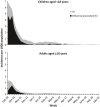Estimating influenza incidence and rates of influenza-like illness in the outpatient setting
- PMID: 22984820
- PMCID: PMC5781202
- DOI: 10.1111/irv.12014
Estimating influenza incidence and rates of influenza-like illness in the outpatient setting
Abstract
Background: Estimating influenza incidence in outpatient settings is challenging. We used outpatient healthcare practice populations as a proxy to estimate community incidence of influenza-like illness (ILI) and laboratory-confirmed influenza-associated ILI.
Methods: From October 2009 to July 2010, 38 outpatient practices in seven jurisdictions conducted surveillance for ILI (fever with cough or sore throat for patients ≥ 2 years; fever with ≥ 1 respiratory symptom for patients <2 years). From a sample of patients with ILI, respiratory specimens were tested for influenza.
Results: During the week of peak influenza activity (October 24, 2009), 13% of outpatient visits were for ILI and influenza was detected in 72% of specimens. For the 10-month surveillance period, ILI and influenza-associated ILI incidence were 20.0 (95% CI: 19.7, 20.4) and 8.7/1000 (95% CI: 8.2, 9.2) persons, respectively. Influenza-associated ILI incidence was highest among children aged 2-17 years. Observed trends were highly correlated with national ILI and virologic surveillance.
Conclusions: This is the first multistate surveillance system demonstrating the feasibility of using outpatient practices to estimate the incidence of medically attended influenza at the community level. Surveillance demonstrated the substantial burden of pandemic influenza in outpatient settings and especially in children aged 2-17 years. Observed trends were consistent with established syndromic and virologic systems.
Keywords: Epidemiology; H1N1; influenza; pandemic.
© 2012 John Wiley & Sons Ltd.
Figures




References
-
- M’ikanatha NM, Lynfield R, Van Beneden CA, de Valk H. Infectious Disease Surveillance, 1st edn Malden, MA, USA: Blackwell Publishing, 2007.
-
- DeStefano F. Opportunities for population‐based clinical research using data from managed care organizations; in Davis J. (ed.): Managed Care Systems and Emerging Infections. Washington, DC: National Academy Press, 2000; 16–18.
-
- Monto AS, Ohmit SE, Margulies JR, Talsma A. Medical practice‐based influenza surveillance: viral prevalence and assessment of morbidity. Am J Epidemiol 1995; 141:502–506. - PubMed
-
- Health Protection Agency . Epidemiological report of pandemic (H1N1) 2009 in the UK April 2009–May 2010. Available at: http://www.hpa.org.uk/webc/HPAwebFile/HPAweb_C/1284475321350. (Accessed 09 July 2012).
Publication types
MeSH terms
Grants and funding
LinkOut - more resources
Full Text Sources
Medical

